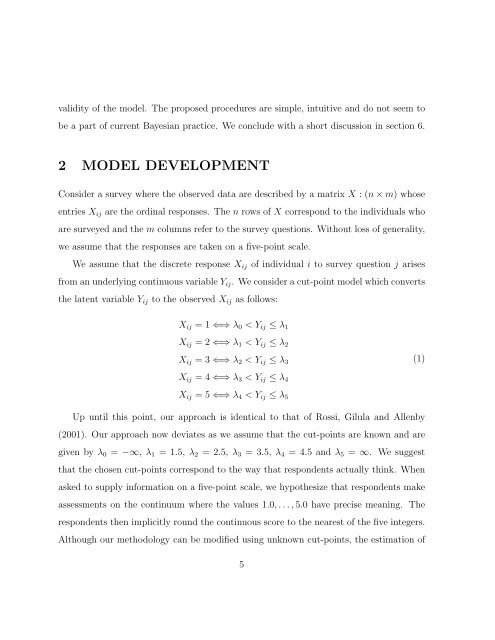Bayesian analysis of ordinal survey data using the Dirichlet process ...
Bayesian analysis of ordinal survey data using the Dirichlet process ...
Bayesian analysis of ordinal survey data using the Dirichlet process ...
Create successful ePaper yourself
Turn your PDF publications into a flip-book with our unique Google optimized e-Paper software.
validity <strong>of</strong> <strong>the</strong> model. The proposed procedures are simple, intuitive and do not seem tobe a part <strong>of</strong> current <strong>Bayesian</strong> practice. We conclude with a short discussion in section 6.2 MODEL DEVELOPMENTConsider a <strong>survey</strong> where <strong>the</strong> observed <strong>data</strong> are described by a matrix X : (n × m) whoseentries X ij are <strong>the</strong> <strong>ordinal</strong> responses. The n rows <strong>of</strong> X correspond to <strong>the</strong> individuals whoare <strong>survey</strong>ed and <strong>the</strong> m columns refer to <strong>the</strong> <strong>survey</strong> questions. Without loss <strong>of</strong> generality,we assume that <strong>the</strong> responses are taken on a five-point scale.We assume that <strong>the</strong> discrete response X ij <strong>of</strong> individual i to <strong>survey</strong> question j arisesfrom an underlying continuous variable Y ij . We consider a cut-point model which converts<strong>the</strong> latent variable Y ij to <strong>the</strong> observed X ij as follows:X ij = 1 ⇐⇒ λ 0 < Y ij ≤ λ 1X ij = 2 ⇐⇒ λ 1 < Y ij ≤ λ 2X ij = 3 ⇐⇒ λ 2 < Y ij ≤ λ 3(1)X ij = 4 ⇐⇒ λ 3 < Y ij ≤ λ 4X ij = 5 ⇐⇒ λ 4 < Y ij ≤ λ 5Up until this point, our approach is identical to that <strong>of</strong> Rossi, Gilula and Allenby(2001). Our approach now deviates as we assume that <strong>the</strong> cut-points are known and aregiven by λ 0 = −∞, λ 1 = 1.5, λ 2 = 2.5, λ 3 = 3.5, λ 4 = 4.5 and λ 5 = ∞. We suggestthat <strong>the</strong> chosen cut-points correspond to <strong>the</strong> way that respondents actually think. Whenasked to supply information on a five-point scale, we hypo<strong>the</strong>size that respondents makeassessments on <strong>the</strong> continuum where <strong>the</strong> values 1.0, . . . , 5.0 have precise meaning. Therespondents <strong>the</strong>n implicitly round <strong>the</strong> continuous score to <strong>the</strong> nearest <strong>of</strong> <strong>the</strong> five integers.Although our methodology can be modified <strong>using</strong> unknown cut-points, <strong>the</strong> estimation <strong>of</strong>5
















